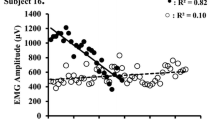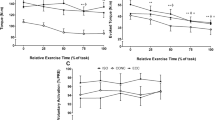Abstract
This study compared force fluctuations during isometric contraction following eccentric exercise of the elbow flexors between young, middle-aged, and old subjects. Ten young (20 ± 2.0 years), 12 middle-aged (48 ± 7.3 years), and 10 old (71 ± 4.1 years) men performed six sets of five eccentric actions of the elbow flexors using a dumbbell weighing 40% of maximal voluntary isometric contraction strength (MVC) at an elbow joint angle of 90° (1.57 rad). MVC was measured before, immediately after, and 1–5 days following exercise, and the force fluctuations were assessed at 30, 50, and 80% of the corresponding time point MVC using coefficient of variation (CV) of force data collected at a frequency of 100 Hz for 4 s. Changes in MVC and CV over time were compared between groups by a two-way repeated measures ANOVA. Changes in MVC following exercise were not significantly different between the young and middle-aged groups, but the old group showed significantly (P < 0.05) smaller decreases in MVC compared with other groups. CV increased significantly (P < 0.05) only immediately after exercise without a significant difference among the three intensities, and no significant differences between groups were evident. It was concluded that force fluctuations during submaximal isometric tasks after eccentric exercise were not affected by age.


Similar content being viewed by others
References
Bazzucchi I, Felici F, Macaluso A, De Vito G (2004) Differences between young and older women in maximal force, force fluctuations, and surface EMG during isometric knee extension and elbow flexion. Muscle Nerve 30:626–635
Burnett RA, Laidlaw DH, Enoka RM (2000) Coactivation of the antagonist muscle does not covary with steadiness in old adults. J Appl Physiol 89:61–71
Carville SF, Rutherford OM, Newham DI (2005) Power output, isometric strength and steadiness in the leg muscles of pre- and postmenopausal women; the effect of hormone replacement therapy. Eur J Appl Physiol 96:292–298
Christou EA (2005) Visual feedback attenuates force fluctuations induced by a stressor. Med Sci Sports Exerc 37:2126–2133
Christou EA, Carlton LG (2001) Old adults exhibit greater motor output variability than young adults only during rapid discrete isometric contractions. J Gerontol A Biol Sci Med Sci 56:B524–B532
Christou EA, Tracy BL (2005) Aging and motor output variability. In: Davids K, Bennett S, Newell KM (Eds) Movement system variability. Human Kinetics, Champaign, IL, USA, pp 199–215
Enoka RM, Christou EA, Hunter SK, Kornatz KW, Semmler JG, Taylor AM, Tracy BL (2003) Mechanisms that contribute to differences in motor performance between young and old adults. J Electromyogr Kinesiol 13:1–12
Erim Z, Beg MF, Burke DT, De Luca CJ (1999) Effects of aging on motor-unit control properties. J Neurophysiol 82:2081–2091
Galganski ME, Fuglevand AJ, Enoka RM (1993) Reduced control of motor output in a human hand muscle of elderly subjects during submaximal contractions. J Neurophysiol 69:2108–2115
Graves AE, Kornatz KW, Enoka RM (2000) Older adults use a unique strategy to lift inertial loads with the elbow flexor muscles. J Neurophysiol 83:2030–2039
Laidlaw DH, Kornatz KW, Keen DA, Suzuki S, Enoka RM (1999) Strength training improves the steadiness of slow lengthening contractions performed by old adults. J Appl Physiol 87:1786–1795
Lavender AP, Nosaka K (2006a) Changes in fluctuation of isometric force following eccentric and concentric exercise of the elbow flexors. Eur J Appl Physiol 96:235–240
Lavender AP, Nosaka K (2006b) Comparison between old and young men for changes in markers of muscle damage following voluntary eccentric exercise of the elbow flexors. Appl Physiol Nutr Metabol 31:218–225
Nosaka K, Sakamoto K (2001) Effect of elbow joint angle on the magnitude of muscle damage to the elbow flexors. Med Sci Sports Exerc 33:22–29
Saxton JM, Clarkson PM, James R, Miles M, Westerfer M, Clark S, Donnelly AE (1995) Neuromuscular dysfunction following eccentric exercise. Med Sci Sports Exerc 27:1185–1193
Semmler JG, Steege JW, Kornatz KW, Enoka RM (2000) Motor-unit synchronization is not responsible for larger motor-unit forces in old adults. J Neurophysiol 84:358–366
Taylor AM, Christou EA, Enoka RM (2003) Multiple features of motor-unit activit influence force fluctuations during isometric contractions. J Neurophysiol 90:1350–1361
Tracy BL, Enoka RM (2002) Older adults are less steady during submaximal isometric contractions with the knee extensor muscles. J Appl Physiol 92:1004–1012
Tracy BL, Byrnes WC, Enoka RM (2004) Strength training reduces force fluctuations during anisometric contractions of the quadriceps femoris muscles in old adults. J Appl Physiol 96:1530–1540
Yao W, Fuglevand AJ, Enoka RM (2000) Motor-unit synchronization increases EMG amplitude and decreases force steadiness of simulated contractions. J Neurophysiol 83:441–452
Author information
Authors and Affiliations
Corresponding author
Rights and permissions
About this article
Cite this article
Lavender, A.P., Nosaka, K. Fluctuations of isometric force after eccentric exercise of the elbow flexors of young, middle-aged, and old men. Eur J Appl Physiol 100, 161–167 (2007). https://doi.org/10.1007/s00421-007-0418-7
Accepted:
Published:
Issue Date:
DOI: https://doi.org/10.1007/s00421-007-0418-7




